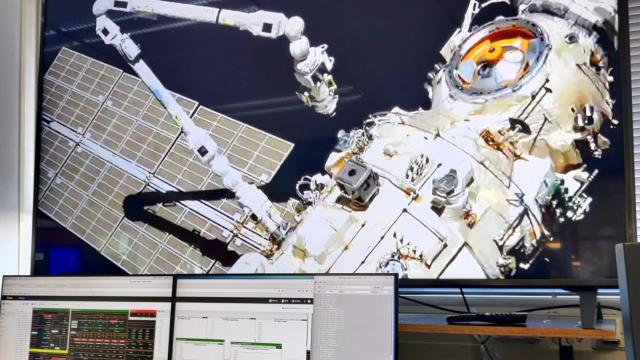The European Space Agency’s giant mechanical arm just pulled off its first manoeuvre, quietly moving a suitcase-sized payload from one side of an orbiting science module to another.
It’s been a rough ride for the European Robotic Arm. Its journey towards installation has been marred by political tensions and failed spacewalks, but despite these external hardships, the 11.28 m-long (3.44 m-long) arm has remained patient and unbothered. Its time has finally come.
On August 24, the European robotic arm successfully completed its first transfer outside the International Space Station, ESA announced on Thursday. By following the commands of onboard Russian cosmonauts, the arm unhooked a small payload from a single pin latch located on the Nauka science module. The robot then moved the payload across to the other side and installed it back to its original position. The entire operation took around six hours, after which the robot went back into hibernation mode.
Launched to space in July 2021, ESA’s robotic arm is designed to function like a human arm but with the ability to move up to 17,600 pounds (8 tonnes) while operating outside the orbiting space station. The robot arm has two hands and is the first robot capable of anchoring itself to the ISS, moving back and forth by shifting one hand over the other like an inchworm. The purpose of the arm is to ease the load of ISS astronauts, quite literally. The giant arm will be used to transfer payloads as they arrive to the space station without the need for spacewalking astronauts. It’s even designed to transport the astronauts themselves while they perform their spacewalks.
A European consortium led by Airbus Defence and Space in the Netherlands designed and developed the robotic arm for ESA. But the robot is not fully installed just quite yet. On Friday, the robot arm is scheduled for more outfitting work as Roscosmos cosmonauts Oleg Artemyev and Denis Matveev venture out on another spacewalk at 9:20 a.m. EST to complete the tasks they weren’t able to finish during their last spacewalk. During the previous attempt to work on the robot arm on August 17, the spacewalk had to be cut short when Artemyev’s spacesuit malfunctioned.
The spacewalk had previously been placed in question due to ongoing tensions between ESA and its Russian counterpart over the Russian invasion of Ukraine. Roscosmos former head Dmitry Rogozin had threatened to withhold access to the robotic arm, even commanding the cosmonauts to discontinue their work on the European robotic arm and instead have ESA’s Director General Josef Aschbacher “fly to space” and do it himself.
But work on the European robotic arm continues, with a so-called “performance mission” planned for September. “Operations will involve evaluating the performance of the brakes, joint motion and [European Robotic Arm’s] force control. Teams on ground will also assess the quality of the images captured by the cameras on its elbows for guiding operations even during the orbital night,” ESA wrote in a statement.
So while the robot is asleep in low Earth orbit for now, it will soon flex its mechanical joints once again for more heavy lifting.
More: Russia Now Wants to Build Its Own Space Station Before Leaving the ISS
